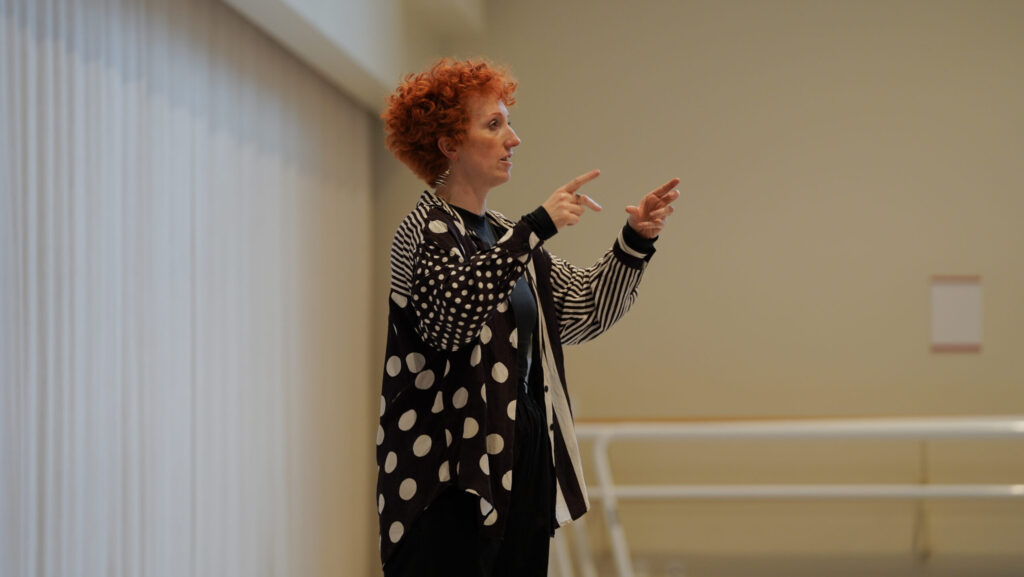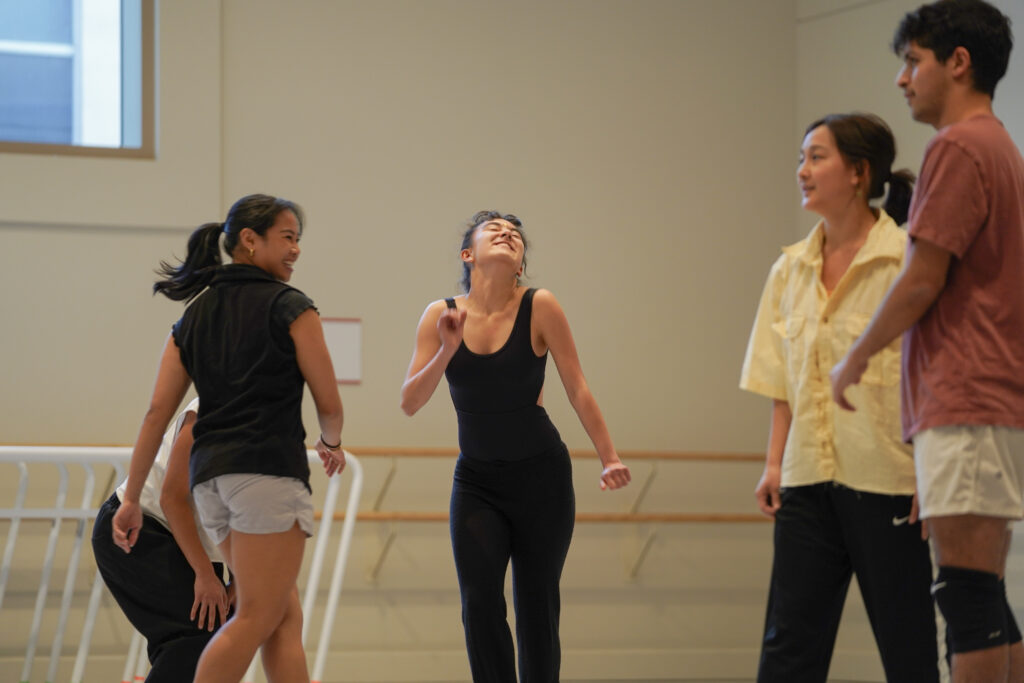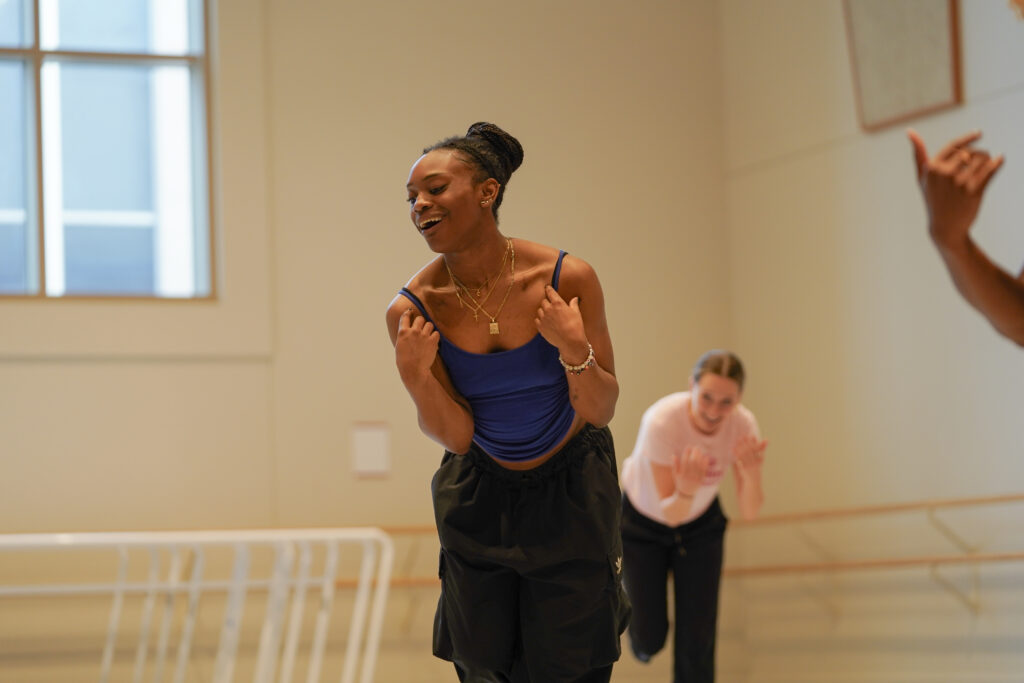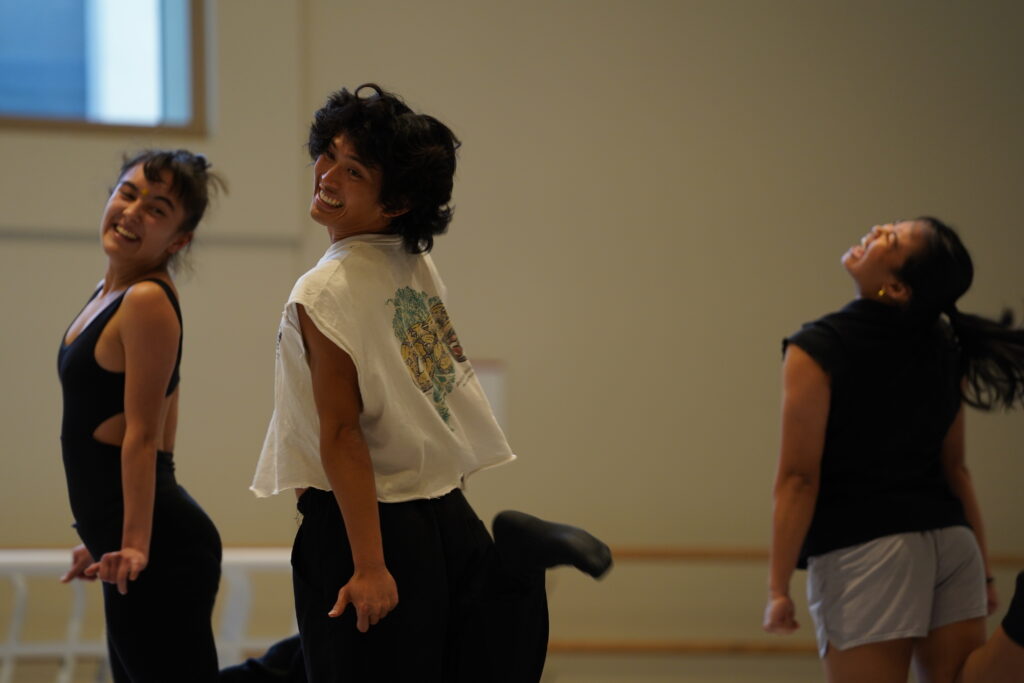Embodying humor: A spotlight on Jillian Meyers
March 31, 2025

Jillian Meyers in rehearsal for her new work | Photo by Hannah Doerr
Jillian Meyers shares the inspiration for her new work at the USC Glorya Kaufman School of Dance. Recounting her experience working with the BFAs, Meyers reveals the process behind her use of humor as both a choreographic device and universal connection point.
By Rhaine Marquardt (BFA ’26)
Intersection at the forefront of Meyers’ new work
Throughout the process of creating this new work, Meyers was driven by the intersection of three distinct ideas that are “the same, but different.” “My work with the Seaweed Sisters was largely fueling this new process. As a choreographic trio, I really like when we are creating within the element of three. It always adds so much variety and surprise, as opposed to when two ideas meet. This becomes more of a push-pull relationship. As soon as you add the third element, it makes the possibilities more dimensional,” she says. “I wondered if this rhythm of funny was something I could extend outward,” she shares. In order to do so, Meyers strived to foster a rehearsal environment where the dancers would feel confident accessing a funny side of themselves. In supporting the BFAs embodiment of humor, she ultimately hoped to “add another tool to their toolbox of sensibilities.”
Playfulness informs the development of abstract narrative
While there is no linear narrative for her new work, Meyers was inspired to create something innately playful. She explains that “it’s ironic because I love narrative type work most of the time. Yet I wanted the dancers to have a space to play.” As an abstract language, Meyers highlights the difficult nature of portraying a clear narrative through physical movement alone. “If you are trying to tell a linear narrative, it needs to be pretty direct,” she says. “I wanted to not have to be so direct about this process.” Fulfilling this vision, Meyers explores how loose and tight movement parameters can coexist. This establishes a unique intersection between improvisation and precision. Within these two choreographic extremes, she encouraged the dancers to play with how they can maintain a sense of character through individuality, uniformity, and all that lies in between.

Versatility as a tool in breaking stylistic boundaries
“I will admit that my movement feeling in life is very squiggly,” Meyers says. Tapping into many aspects of her diverse training background, Meyers shares that she “squiggles” through various dance forms including tap, jazz, and contemporary when choreographing. “It has really been a joy watching these iterations of myself on the dancers,” she explains. Meyers channels her multifaceted training background into a piece that encompasses several forms, blurring the lines of stylistic distinction. Furthermore, she allows feeling to inform the process rather than one specific discipline. In addition to feeling, Meyers places musicality at the forefront of her choreographic process. She highlights that her “favorite form of play now as a dancer is usually within musicality.” Using a piece of music that is relatively rigid in timing, Meyers nurtures complex physical timing within exacting musicality.
Meyers’ use of humor as a choreographic methodology
Due to the subjective nature of humor, Meyers emphasizes how humor expressed through dance can often be lost on non-dancers. Within her new work, she actively explores aspects of humor that permeate not only people who know dance, but people beyond familiar ties to the art form. Bridging the gap between humanistic qualities and a dancing physicality, Meyers experiments with choreography that reflects universal feelings without using words. “That’s what I am always after, the non-verbal things that we can all resonate with,” she says.
Many expressions of humor are dependent on language. However, dancers are faced with the challenge of using their bodies to emulate humor. Drawing upon human experiences that are funny — while also relatable to many — Meyers experiments with how she can express human feelings in a choreographically amplified way. In this playful process, Meyers is engaged in a physical research of humor. She refines ideas to the point of readability, but prior to becoming overly inauthentic.

Balancing spontaneity and structure
Beginning the first section of the piece in silence, Meyers allows the dancers ample time to communicate and respond to an audience. The absence of boundaries created by stringent musicality promotes a seamless connection between the BFAs and audience members. “The pinnacle of humor as a craft,” as Meyers describes, is the ability to maintain this connection with the audience as the introduction of music forces the dancers to orchestrate these same feelings to particular timing.
“When the music is going, looseness can feel good from a dancer’s perspective. However, the audience actually needs some precision to register what the dancers are doing and trying to say,” she explains. The expression of genuine humor within this new work is dependent on “finding a place where you can hold onto that feeling of spontaneity while hitting the same step every time,” Meyers says. She encourages the BFAs to explore how they can make physical repetition feel spontaneous as the music is introduced. As Meyers highlights, embodied intersection points between spontaneity and structure are “about a balance of agreed upon timing in the music that can guarantee some of the funny moments, while still leaving some moments open for real time exploration.”
Inviting the audience to become a performer
In Meyers’ eyes, the audience is an active player in performance. “As a performer, I always want to bring the audience in on whatever I’m feeling,” she shares. Meyers invites the audience to shift their role from passive observer to active participant in this new work. Throughout the rehearsal process, Meyers encouraged the BFAs to invite viewers in on the fun. She describes how something seemingly simple — such as dropping the chin while dancing — can help to open up dancers’ vision. This allows them to both see and connect with audience members. Bridging the gap between audience and performer, Meyers unites two worlds in hopes of “bringing accountability to an audience member.” She emphasizes the power seeing an audience member has in making them feel accountable and invested in the moment.

Meyers’ says “yes, and” with the BFAs
“I feel so grateful for the dancers’ generosity in playfulness,” Meyers says. “Though I consciously chose to do something that I thought would likely be outside of some comfort zones, I was pleasantly surprised how quickly the energy of the room said ‘yes, and’.” Met with a sense of dedicated attention and vulnerability, Meyers expresses gratitude for the BFAs wholehearted investment in the creation process. “There was never a day when I felt like people were only half in,” Meyers says, reflecting on her time at USC Kaufman, “It was a huge gift.”
After careful consideration, Meyers concludes the essence of her new work at USC Kaufman to be an embodied form of doodling. “In my mind, we are doodling all over the space with our thoughts and feelings,” she says.